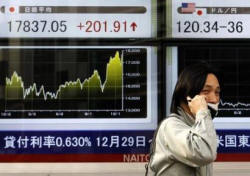|
 Draghi
drives euro to four and a half year low Draghi
drives euro to four and a half year low
 Send a link to a friend
Send a link to a friend
[January 02, 2015]
By Patrick Graham
LONDON (Reuters) - The euro started 2015
with another downward lurch, hitting a 4-1/2 year low against the dollar
on clear indications that the European Central Bank will soon embark on
outright money-printing.
|
|
Yields on government bonds issued by the euro zone's heavily
indebted southern member states - which the bank would be expected
to buy in any such campaign of quantitative easing - also fell on
Friday after ECB President Mario Draghi said the risk of it falling
short of its mandate on inflation targeting had risen compared to
six months ago.
Stock markets in Europe turned lower after initial gains, driven by
a downward revision of purchasing manager surveys for France and the
euro zone as a whole. The pan-European FTSEurofirst 300 index fell
0.3 percent.
Wall Street's main indexes, however, were set to open higher, while
the dollar hit a nine-year peak against a basket of major
currencies.
The divergence expected between European and U.S. monetary policy in
2015 dominated currency markets' thinking last year, and Draghi's
signal that the ECB was preparing for more action added to
expectations that it will step in soon.
"The risk is on the downside for the euro after these comments,"
said Niels Christensen, an FX strategist at Nordea in Copenhagen.
"It could break below $1.20 since there is a risk of a very low
inflation reading out of the euro zone next week. That will just add
to pressure on the ECB to take measures when it meets later this
month."
The ECB, which targets inflation at just below 2 percent, next meets
on policy on Jan. 22. Euro zone inflation data next Wednesday is
forecast to show prices falling in annual terms.
The interest rate premium investors demand to buy Spanish over
German bonds dipped below 100 basis points for the first time since
April 2010, reflecting expectations yields in Spain, Italy and
Portugal would fall in any QE campaign.
The euro fell as far as $1.2035, depths last seen in mid-2010. The
dollar's broad strengthening included a rise to 120.48 yen.
[to top of second column] |

Oil prices remained fragile after a savaging in the second half of
2014. U.S. crude futures added 18 cents to $53.45 a barrel, while
Brent was steady at $57.33.
"Many of the themes that were in vogue heading into the end of the
year remain very much firmly in place," said Callum Henderson,
global head of FX research for Standard Chartered Bank in Singapore.
"The U.S. recovery is not stellar but it's certainly materially
better than in most places in the G10."
Stock markets in Asia were relatively calm with China, Japan,
Thailand and the Philippines all on holiday. Australia's main index
and South Korea's both added 0.5 percent and Hong Kong gained 0.8
percent.
China on Thursday reported its official Purchasing Managers' Index (PMI)
slipped to 50.1 in December, the lowest level of 2014 and barely in
expansion territory. That blow was softened by a rise in the service
sector PMI to 54.1.
(Editing by Susan Fenton)
[© 2014 Thomson Reuters. All rights
reserved.] Copyright 2014 Reuters. All rights reserved. This material may not be published,
broadcast, rewritten or redistributed. |